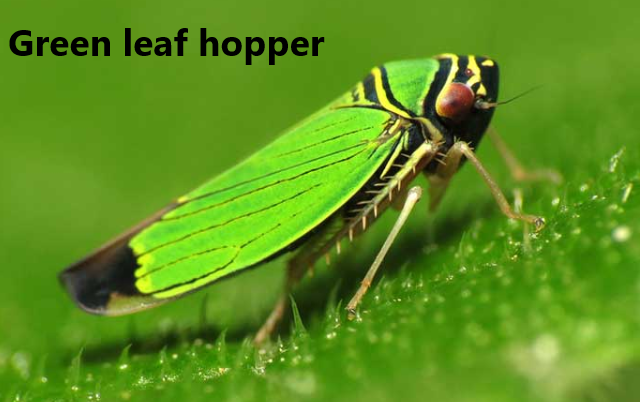Green leafhopper
- Scientific Name: Nephotettix virescence.
- Family: Cicadellidae.
- Order: Hemiptera.
Pest characters of Green leafhopper
- Both nymph and adult are harmful.
- Mouthparts → piercing-sucking type.
- Green in color.
Nature of Damage of Green leafhopper
1. Eggs are laid in rows on the midrib of the leaf sheath.
2. After 36 days the eggs are hatched, both nymphs and adults are harmful and they can damage by 2 types.
Direct damage of Green leafhopper
1. Both nymphs and adults suck the cell sap from the leaves of the plant.
2. Due to sucking cell sap, the plant conducting tissues become collapsed, and as a result plant materials cannot move upward.
3. Then the infested plants become yellow and lose vitality and vigor due to lack of photosynthesis.
4. Finally burning symptoms appear in patches in the infested field which is known as “hopper burn”.
5. They can do damage by lacerating the plant tissues with ovipositor which facilities microbial infection.
Indirect damage of Green leafhopper
1. GLH cause Tungro disease and yellow dwarf disease by carrying tungro virus and yellow dwarf virus respectively.
2. Photosynthesis reduction occurs this insect secrets honeydew on plants which later helps for the production of sooty mold fungus grows. Finally, yield reduction occurs severely.
Green leafhopper management/control measures
A) Non-chemical control of Green leafhopper
- Removing excess water from the field.
- The use of excess nitrogenous fertilizer should be avoided.
- Optimum plant densities should be maintained.
- Crop rotation should be followed.
- Cultivation of insect-resistant varieties such as BR 1, BR 2, BR 3, BR 10, and BR 26.
- Destruction of ratoon crops.
- Using a light trap for controlling adults.
- Trichoparammatic parasitoids Paracenhotio andio can be used.
- Preservation of damselfly and spider Chicosa pxudoamdata.
B) Chemical control of Green leafhopper
- Application of Malathion/ Maladan/ Zithiol 57 EC @ 404 ml/ acre of land.
- Application of Sumithion/ Edfan 50 EC @ 404 ml/ acre of land.
- Using granular insecticides. e.g. Basudin 10G, Furadan 3G @ 16.5 kg/ha.
- Application of Metasistox @ 1.5 L/ ha.
- Application of Tapgor or Racion @ 12 L/ ha.
